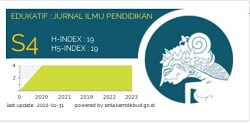Model Kepemimpinan Berbasis Budaya Pesantren di Madrasah Aliyah
Abstract
Madrasah di bawah naungan Nahdlatul Ulama (NU) memiliki karateristik tertentu yang membuat MA NU Banat mempunyai keunggulan-keunggulan tertentu. Kepemimpinan kepala madrasah berbasis budaya pesantren adalah corak kepemimpinan yang bercirikan budaya, termasuk nilai, dan semangat pesantren. Budaya pesantren sendiri merupakan implementasi dari nilai-nilai keislaman. Ciri budaya pesantren adalah tidak ragu untuk mengambil budaya baru yang lebih baik, di samping mempertahankan budaya lama yang baik. Nilai lama yang dipertahankan adalah manajemen tauhid dan nilai baru yang diambil adalah Total Quality Management (TQM).
Keywords
Full Text:
PDFReferences
Ahmad, K., & Fontaine, R. (2011). Islamic leadership at the international Islamic University Malaysia. International Journal of Economics, Management and Accounting, 19(2).
Ali, A. M. (1987). Beberapa persoalan agama dewasa ini. Rajawali Pers.
Brown, J. D. (1998). The self. McGraw-Hill.
Carpenter, D. (2015). School culture and leadership of professional learning communities. International Journal of Educational Management, 29(5), 682–694. https://doi.org/10.1108/IJEM-04-2014-0046
Cheng, B. S., Chou, L. F., Wu, T. Y., Huang, M. P., & Farh, J. L. (2004). Paternalistic leadership and subordinate responses: Establishing a leadership model in Chinese organizations. Asian Journal of Social Psychology, 7(1), 89–117. https://doi.org/10.1111/j.1467-839X.2004.00137.x
Desa, K. N., & Kassim, N. A. (2010). Transformational leadership enhances customer satisfaction. Problems and Perspectives in Managements, 4, 107–112.
Dorfman, P. W., Howell, J. P., Hibino, S., Lee, J. K., Tate, U., & Bautista, A. (1997). Leadership in Western and Asian countries: Commonalities and differences in effective leadership processes across cultures. Leadership Quarterly, 8(3), 233–274. https://doi.org/10.1016/S1048-9843(97)90003-5
Haedari, A., & Pesantren, M. D. (2004). Dalam Tantangan Modernitas dan Tantangan Komplesitas Global. Jakarta: IRD Press.
Hofstede, G. J. A. N. (n.d.). 2005文化和组织.
House, R. J., Hanges, P. J., Javidan, M., Dorfman, P. W., & Gupta, V. (2004). Culture, leadership, and organizations: The GLOBE study of 62 societies. Sage publications.
Ibrahim, I. Bin, & Don, Y. Bin. (2014). Servant Leadership and Effective Changes Management in Schools. 4(1), 1–9.
Khalifa, B., & Ayoubi, R. M. (2015). Leadership styles at Syrian higher education: what matters for organizational learning at public and private universities? International Journal of Educational Management.
Lahtero, T. J., & Risku, M. (2014). Symbolic leadership culture and its subcultures in one unified comprehensive school in Finland. International Journal of Educational Management.
Leadership, T., & Satisfaction, J. (2012). The Effect of Organizational Culture and the Relationship between The Effect of Organizational Culture and the Relationship between Transformational Leadership and Job Satisfaction in Petroleum Sector of Libya. December 2015. https://doi.org/10.5539/ibr.v5n9p89
Littrell, B. (2002). Gideon Sjoberg, methodology and symbolic interaction. In Studies in Symbolic Interaction. Emerald Group Publishing Limited.
Mas’ ud, A., Ismail, S. M., Huda, N., & Kholiq, A. (2002). Dinamika pesantren dan madrasah. Kerjasama Fakultas Tarbiyah, IAIN Walisongo dengan Pustaka Pelajar, Yogyakarta.
Oedjoe, M. R. (2016). Keefektifan kepemimpinan perempuan sebagai kepala sekolah. Jurnal Ilmu Pendidikan, 11(2).
Pettigrew, A. M. (1979). Pettigrew 1979. Quarterly, Administrative Science Dec, Qualitative Methodology, 24(4), 570–581. https://anderson.leadershipacademy.nhs.uk/pluginfile.php/3700/mod_resource/content/4/PETTIGREW 1979.pdf%5Cnpapers3://publication/uuid/8CE84800-C819-4167-849F-7D61C91E77F1
Pidarta, M. (2004). Manajemen Pendidikan Indonesia, PT. Rineka Cipta, Jakarta.
Spradley, J. P. (2007). Metode Etnografi, terj. Misbah Zulfa Elizabeth. Yogyakarta: Tiara Wacana.
Spradley, J. P., & others. (1997). Metode etnografi.
Stephen, R. (2004). Organizational Behavior.
Stogdill, R. M. (1974). Handbook of leadership: A survey of theory and research. Free Press.
Syukur, F. (2015). Model Manajemen Madrasah Aliyah Efektif (Studi pada Tiga Madrasah Aliyah di Kudus). INFERENSI: Jurnal Penelitian Sosial Keagamaan, 9(2), 467–490.
Tajasom, A., & Ariffin Ahmad, Z. (2011). Principals’ leadership style and school climate: teachers’ perspectives from Malaysia. International Journal of Leadership in Public Services, 7(4), 314–333. https://doi.org/10.1108/17479881111194198
Tribus, M. (2010). Total Quality Management in education. In Developing quality systems in education. https://doi.org/10.4324/9780203423660_chapter_5
Umar, H. N. (2014). Ketika fikih membela perempuan. Elex Media Komputindo.
DOI: https://doi.org/10.31004/edukatif.v4i2.2594
Article Metrics
Abstract view : 325 timesPDF - 171 times
Refbacks
- There are currently no refbacks.
Copyright (c) 2022 Nanang Qosim

This work is licensed under a Creative Commons Attribution-ShareAlike 4.0 International License.






1.png)